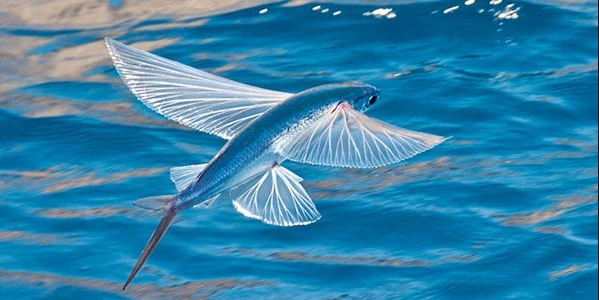Facts about fish that can fly

Stay tuned with 24 News HD Android App

Flying fish are ray-finned fish with highly modified pectoral fins. Despite their name, flying fish aren’t capable of powered flight. Instead, they propel themselves out of the water at speeds of more than 35 miles (56 km) an hour. The maximum altitude is 6 m above the surface of the sea. Flying fish often accidentally land on the decks of smaller vessels.
Once in the air, their rigid “wings” allow them to glide for up to 650 feet (200 meters). They can travel at speeds of more than 70 km/h (43 mph).
The winglike pectoral fins are primarily for gliding—the fish hold the fins flat at their sides when swimming. Their streamlined bodies reduce drag when the fish are “flying.”
Another interesting characteristic of the flying fish is its unevenly forked tail, which has a top lobe that’s shorter than the bottom lobe.
Flying fish can be up to 18 inches (45 cm) long, but average 7 to 12 inches (17 to 30 m).
There are roughly 40 species of flying fish. Flying fish are tropical and temperate marine species that can be seen off both the Atlantic and Pacific coasts of the United States. They are also found in the Atlantic, Pacific, and Indian Oceans. Open oceans provide habitat for most flying fish, but some live instead on the outskirts of coral reefs.
It’s thought that flying fish evolved a flying mechanism to escape from their many oceanic predators. Once in the air, though, they sometimes become food for birds. Young flying fish may have filaments protruding from their lower jaws that camouflage them as plant blossoms.
Barbados is known as "the land of the flying fish", and the fish is one of the national symbols of the country. Once abundant, it migrated between the warm, coral-filled Atlantic Ocean surrounding the island of Barbados and the plankton-rich outflows of the Orinoco River in Venezuela.
The Exocet missile is named after them, as variants are launched from underwater, and take a low trajectory, skimming the surface, before striking their targets.
In May 2008, a Japanese television crew (NHK) filmed a flying fish (dubbed "Icarfish") off the coast of Yakushima Island, Japan. The fish spent 45 seconds in flight. The previous record was 42 seconds.
Flying fish are commercially fished in Japan, Vietnam, and China by gillnetting, and in Indonesia and India by dip netting.
Often in Japanese cuisine, the fish is preserved by drying to be used as fish stock for dashi broth.
The oldest known fossil of a flying or gliding fish is those of the extinct family Thoracotomies, dating back to the Middle Triassic, 235–242 million years ago. However, they are not related to modern flying fish, with the wing-like pectoral fins being convergently evolved in both lineages.
